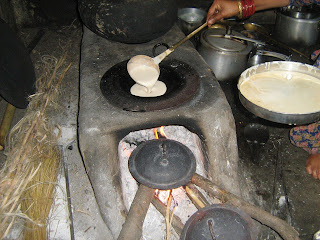Jakholi (जखोली), a fair held every year on 2nd June at Kameda (कमेडा) near Bastil in Bawar, this year ( 2008) was a unique event with a lot of spiritual/religious significance attached. It was after a long time that the three Birs of Lord Bashik (the eldest of the Four Mahasu Devata Brothers - Bashik, Botha, Pavasi and Chalda) descended/ came to Kameda (कमेडा) with their Palkis to bless devotees. Those who take turns to sway it to especial drum beats as a mark of paying their respects are considered particularly lucky ones. Palki is a well decorated/consecrated Box. It contains the Lord's idols and other symbols. Wears Holy colthing around, the Palki is seated in the middle of parallel wooden bars which help in carrying the Palki on shoulders.
The three Birs of the Lord Mahasu named Shedkudia Bir of Deoghar area, Shedkudia Bir of Himachal and Kayalu Bir who has got a small temple at the place, added to the sanctity to solemn occassion of Jakholi. Kameda (कमेडा) overflew with young and old rushing from all places for joining their near and dear ones this year to not only share the joy but to also receive the blessings of the revered deities.
To begin with, the girls lead a procession from Bastil with the beats of Dhol- damanon (local drum band). This perhaps is the only place in the entire Jaunsar Bawar, may be only one such place, where daughters are given such a pride of precedence over sons. The Fair formally starts after Girls (daughters) of Bastil village have offered their prayers at Kameda. It is only after they have commenced the formal celeberations in the form of a traditional song, etc that others could join in the singing and dancing on the occassion. Thereafter, the Palki of Lord Bashik is brought out for the Darshan. Devotees vy with each other to earn a chance to ferry the Palki on their shoulders to the beats of band for a Divine dance of the Lord's Palki.
The Fair is organised as a celebration of the coming of the eldest Mahasu Gods to Kameda from Koti- Kanasar in response to the prayers of the Girls-Daughters of Bastil. It is beleived that the Lord Mahasu's Bazir who hailed from Rana clan of Bastil, didnot have daughters. He prayed to the Lord Bashik and was blessed with beautiful daughters. Thus all the daughters of Rana clan of Bastil became blessed ones. As these girls/daughters of Bastil found it very difficult or almost impossible to travel to Koti Kanasar for offering their prayers, the Lord Bashik ordained that He would shift His base to Mendrath. The Lord Bashik chose Jakholi Fair to be held at Kameda a place near Bastil- Kuna, on the road to Kathyan.
Kameda the venue of Jakholi Fair, is surrounded by deodars and is a very beautifull place with sprawling natural lawns. The abundance of Pine and Deodar trees in Bawar region add to the scenic beauty of the area which is part of the higher reaches of Jaunsar Bawar hills in the middle Himalayas.
Everyone from Bawar, their relatives, near & dear ones and also people from Jaunsar keenly await this fair. The event befalls on a very convenient day when those away in government jobs or settled outside could easily come back as the schools are closed for summer holidays. Moreover farming activities in the area is not too demanding around that time. This ensures extensive participation. The Jakholi Fair is quite popular amongst the people in surrounding areas of Jaunsar, Uttarkashi and Himachal Pradesh.
It may be noted that The Mahasu Gods are equally revered and worshiped in the parts of Himachal Pradesh and Uttarkashi as in Jaunsar Bawar. Hanol, the main seat of the Lord Mahasu Brothers is located near Bastil. The Rana Clan of Bastil is endowed with the blessings of the Lord as Bazirs, to manage affairs, including looking after accounts, store, upkeep, etc.


























































